|
|
Circuit elements
- Current (I = ΔQ/Δt, sign conventions, units)

- Current is the rate of charge flow through the cross-section of a conductor (wire).
- Traditionally, the direction of current is taken as the flow of positive charges.
- The unit for current is Coulombs per second, C/s.
- Battery, electromotive force, voltage
- Electromotive force (emf) is really not a force, but a potential difference, with the unit voltage.
- A battery is a source of emf.
- If the battery has no internal resistance, then potential difference across the battery = EMF.
- If the battery has internal resistance, then potential difference across battery = EMF - voltage drop due to internal resistance.
- Terminal potential, internal resistance of battery
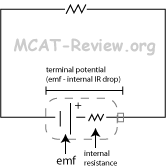
- Terminal potential is the voltage across the terminals of a battery.
- Internal resistance of a battery is like a resistor right next to the battery connected in series.
- Terminal potential = EMF - IRinternal
- Resistance
- Ohm's law (I = V/R)
- resistors in series
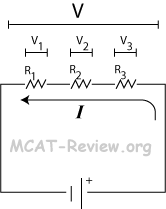
- Iseries = I1 = I2 = I3
- All resistors in series share the same current.
- Vseries = V1 + V2 + V3
- Voltage drop among resistors in series is split according to the resistance - greater resistance, greater voltage drop (V = IR).
- resistors in parallel
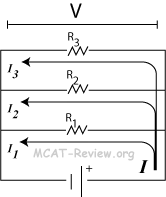
- Vparallel = V1 = V2 = V3
- All resistors in parallel share the same voltage.
- Iparallel = I1 + I2 + I3
- Current among resistors in parallel is split according to the resistance - greater resistance, less current (I = V/R).
- resistivity (ρ = RA/L)
- Resistivity is the inverse of conductivity.
- Greater resistivity, greater resistance of the material.
- Rearranging the above equation to get R = ρL/A. To make a wire of low resistance, select a material that has low resistivity, keep the wire short, and keep the diameter of the wire large.
- Extension cords are made really thick to keep the resistance down, so it doesn't heat up and cause a fire.
- Capacitance
- concept of parallel-plate capacitor
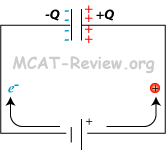
- C = Q/V = εA/d
- Greater capacitance is created by a greater charge on plates (Q) for a given voltage (V), greater plate area (A), or smaller distance between plates (d).
- V = Ed, where V is voltage across capacitor, E is electric field between capacitor, and d is the distance between capacitor plates.
- energy of charged capacitor
- U = Q2/2C = ½QΔV = ½C(ΔV)2
- U is the potential energy of the charged capacitor, Q is charge stored (magnitude of either +Q or -Q on one of the plates), C is capacitance.
- capacitors in series
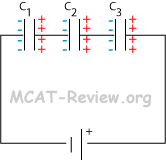
- 1/Ceq = 1/C1 + 1/C2 + 1/C3
- capacitors in parallel
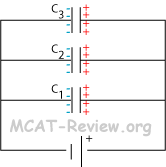
- Ceq = C1 + C2 + C3
- dielectric
- Dielectric = nonconducting material.
- Inserting a dielectric between the plates of a capacitor increases the capacitance by either increasing Q (if V is constant) or decreasing V (if Q is constant).
- V = V0/κ
- C = κC0
- Discharge of a capacitor through a resistor
- Charge
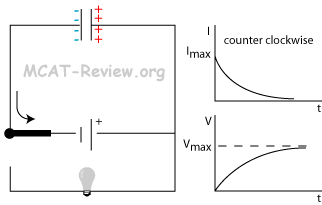
- Discharge
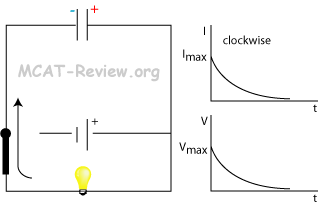
- During the discharge of a capacitor, the capacitor acts as a battery and drives current flow, which decreases with time as the capacitor discharges.
- Conductivity theory
- Conductivity is affected by electrolyte concentration:
- No electrolyte, no ionization, no conductivity.
- Optimal concentration of electrolyte, greatest conductivity due to greatest mobility of ions.
- Too much electrolyte, ions are too crowded, less ion mobility, less conductivity.
- Conductivity is affected by temperature:
- In metals, conductivity decreases as temperature increases.
- In semiconductors, conductivity increases as temperature increases.
- At extremely low temperatures (below a certain critical temperature typically a few degrees above absolute zero), some materials have superconductivity - virtually no resistance to current flow, a current will loop almost forever under such conditions.
- Conductivity (σ) is the inverse of resistivity (ρ).
- Place a capacitor inside a solution, the solution will conduct a current between the plates of the capacitor, thus you can measure the conductivity of a solution using a capacitor.
Circuits
- Power in circuits (P = VI, P = I2R)
- P = IV = I2R
- P is power, I is current, V is voltage, R is resistance.
- Power companies try to save the amount of copper needed for power lines by using thinner wires, which makes R quite high.
- To minimize P dissipated by the wires, they minimize I by maximizing V. This is why power lines transfer electricity at high voltage.
Alternating Currents and Reactive Circuits
- Root-mean-square current
- Irms = Imax/√2 = 0.7 Imax
- Root-mean-square voltage
- Vrms = Vmax/√2 = 0.7 Vmax
- Vrms = IrmsR
- Pavg = IrmsVrms = I2rmsR
|
|
